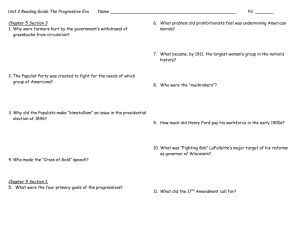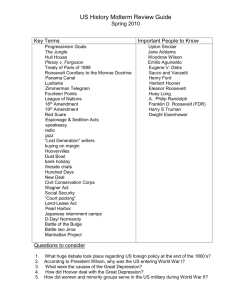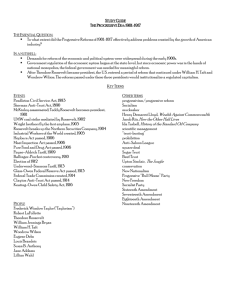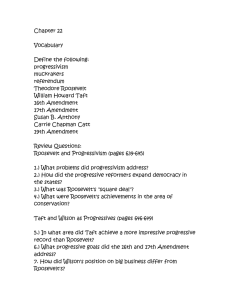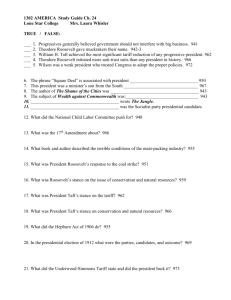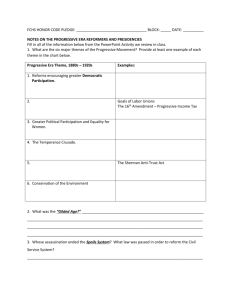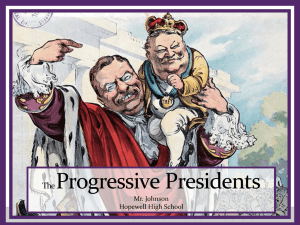7.02 Attempts at Reform
advertisement
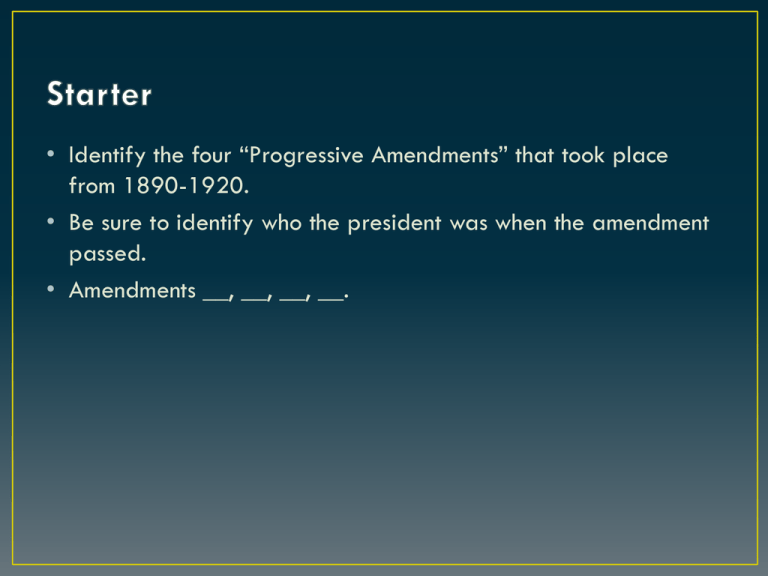
• Identify the four “Progressive Amendments” that took place from 1890-1920. • Be sure to identify who the president was when the amendment passed. • Amendments __, __, __, __. 7.02 Analyze how different groups of Americans made economic and political gains in the Progressive Period. • Reformer review: • Writer who exposed the poor conditions in the tenements • Opened the Hull House in Chicago which served immigrants and workers. The opening of the Hull House led to the settlement house movement in many big cities across the country. • Temperance Movement gained momentum in the Progressive Period. • Originally a movement to limit alcohol; it became a movement to eliminate alcohol. • Led to the 18th Amendment (1919) which prohibited the making, sale, or transportation of alcohol (PROHIBITION). • Amendment is later repealed by the 21st Amendment. • Leader in the Temperance Movement. • Went into saloons smashing bottles of liquor with a hatchet while singing hymns and reciting Bible verses. Progressive Movement • 1901: Theodore Roosevelt (R) became president. • 1902: Anthracite Coal Mine Strike occurred in which miners (150,00+) were demanding higher pay, shorter work days, and union recognition. Mine owners would not negotiate. • Roosevelt called both sides to the White House and threatened to send in army troops. • Mine owners agreed to a process in which parties submit their differences to a neutral third party for judgment. This process is called... • Roosevelt did not oppose big business, but he did believe government regulations were necessary. • Ruling in 1895 United States v. EC Knight Company went against the government and stated monopolies could not be broken up. • Roosevelt felt that any monopoly was harmful. • Elkins Act restrained railroads by making rebates illegal. • Northern Securities v. US (1904), Roosevelt tried to break up the railroad monopoly in the Northwest. The Supreme Court ruled the company violated the Sherman Antitrust Act and must be broken up. • Theodore Roosevelt gains the nickname, “The Trustbuster.” • Theodore Roosevelt agreed not to run for reelection in 1908 and endorsed his friend, Taft. • Not the reformer as Roosevelt, Taft championed a number of progressive causes • Mann-Elkins Act: expanded power of the Interstate Commerce Commission to regulate telephone and telegraph rates (these companies had to cross state lines) • Brought more antitrust cases to court than TR did! • Ex: American Tobacco v. US in which the Duke family (NC) had a monopoly over tobacco manufacturing. Supreme Court ruled the company must be broken up. James “Buck” Duke –(Duke University) • Payne-Aldrich Tariff (1909): Taft wanted to lower tariffs to help consumers. However, Congress modified the tariff and taxes rose before it was signed into law. • Outraged, Theodore Roosevelt who came back to run in the election of 1912. • Candidates • Woodrow Wilson (D). • Theodore Roosevelt (Progressive Party) • William Howard Taft (R) • Republicans split over which candidate to vote for (Taft or Roosevelt). • Progressive Party was nicknamed the “Bull Moose Party” after TR stated that he was, “Stronger than a bull moose.” • Many women joined the party • Progressives argued for direct election of senators. • Democrat, Wilson, won the election and entered office in 1913. • In the election of 1912, Wilson ran opposed big business and big government. • Desired to enforce antitrust laws without threatening free economic competition. • Federal Reserve Act (1913) established an organization to oversee banking, control circulation of money, and help prevent bank failures. • Clayton Antitrust Act (1914) make strikes, peaceful protest, and boycotts legal. (Employers could no longer break up labor unions.) The Progressive Period Congress now had the power to collect taxes on the incomes of businesses and individuals. This amendment increased the federal government’s revenue and eliminated the need to tax according to the proportions of state populations This law established the US senators would be elected directly by the people, rather than by state legislatures. The government prohibited the making, selling, or transporting of alcoholic beverages. This amendment was later repealed by the twenty-first Amendment. Gave women the right to vote. • Most famous figure for reforming state government • Political leader who gain national attention as a reformer • Wisconsin governor from 1901 to 1906. • 1903 adoption of direct primary (people choose the candidates in political races rather than by party bosses) • “Wisconsin Idea” laid out a plan for a merit system for civil service and state regulations (and taxes) on railroads. • Within 10 years, every state adopted the direct primary reform Recall • Special election to remove corrupt officials • Allowing citizens to vote directly on government proposed laws • Allowing citizens of a state to force a vote on particular issues (force the representative to vote the way the voters want) • Allowing citizens to vote in secret. Also known as the… • Hiram Johnson—California • Theodore Roosevelt—New York • Woodrow Wilson—New Jersey • Roosevelt and Wilson later became Presidents and brought reforms to the White House. • Political machines and corrupt bosses like _________________ left people calling for reform in the cities. • Many new models for running the city emerged. • Commissions were groups elected by the people that ran the city instead of a mayor or individual. • City manager could be hired and answered to the commission (or city council) who were elected by the people. • By the early 1920’s, nearly 300 cities had city managers. • City Councils came to be used to hold elected leaders, such as mayors • Page 142 #1-3 • Number 3 MUST be answered in complete sentences. • Add to the responses from page 138. • REMEMBER that this will be turned in as ONE assignment once Goal 7 is completed. • In assigned groups, create a poster visual to hang in the classroom reminding you of Progressive Amendments to the Constitution during the time period 1890-1920. • 16, 17, 18, 19 • You MUST use a visual for each amendment and explain the amendment in your own words. • USE markers and lots of color. You want this to be an eyecatcher.
